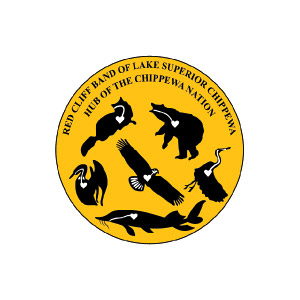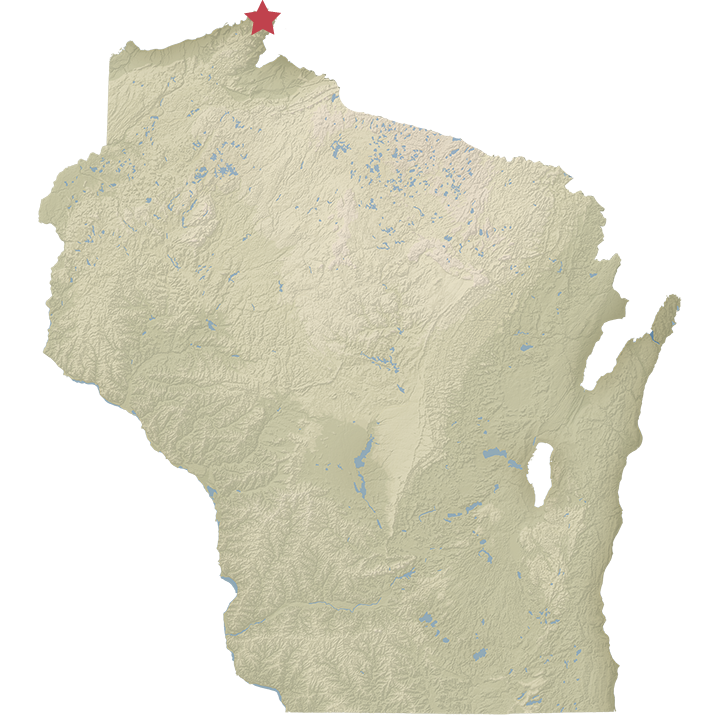
Brief History
The Anishinaabe, also referred to as Chippewa or Ojibwe, migrated from present-day eastern Canada and the United States to what is now known as Madeline Island in Lake Superior. The Anishinaabe were told by a prophet that a sacred shell would guide them on a generations-long journey moving west. The journey included seven stops and, ultimately, to the place where the food that grows on the water. The seventh and final stop was at the island called ‘Moo-ning-wana-kawn-ing’, which means the place of the yellow flicker bird. Centuries later, this island was renamed “Madeline Island” in honor of an Anishinaabe woman, Ikwesewe (Madeleine Cadotte), wife of a French fur trader who established the first fort and settlement there in 1693. What would become known as the Red Cliff Band of Lake Superior Chippewa journey ended near present-day Bayfield, Wisconsin, an area of abundant wild rice.
Among the smallest of the Indian reservations in Wisconsin today, the Red Cliff Band of Lake Superior Chippewa was originally part of the La Pointe Band, which also consisted of the Bad River Band of Lake Superior Chippewa. This band was the primary village of Chief Buffalo, who, in the 1800s was leader of the Anishinaabe. Chief Buffalo was most widely known for his role as a peacemaker in the formation of the Treaty of 1854. At the time, this treaty ceded the largest amount of land in the northern and western shores of Lake Superior. The 1854 Treaty also set aside 200 acres on Madeline Island for traditional gathering practices for its members. This island is a longtime capital and cultural or religious center of the Ojibwe people and nations throughout the Great Lakes region.
The 1854 Treaty also established reservations for other Ojibwe bands of Wisconsin, including Bad River, Lac du Flambeau, and Lac Courte Oreilles; the other two Ojibwe bands are the St. Croix and Mole Lake Nations. The influx of settlers into Wisconsin progressively displaced the Ojibwe from their traditional use of the ceded lands.
Prior to the Treaty of 1854 and despite several earlier treaties, the U.S. Government attempted to eliminate or remove all American Indian nations to locations west of the Mississippi River with the passage of the Indian Removal Act of 1830.
Chief Buffalo, with Chief Oshogo, and other Clan Chiefs of the Grand Council challenged the past treaty agreements and accused the federal government of carrying out a great deception towards the Ojibwe in earlier treaty negotiations.
At age 93, Great Buffalo and several band chiefs were delegated to begin the months-long journey to Washington, D.C. to meet with U.S. President Millard Fillmore. When they finally met, they carried the words of the Grand Councils and a Pa-wa-gon, or great pipe, which was smoked with the President. Following the meeting, the chiefs returned home with that pipe, now known as the “Buffalo Peace Pipe, ” symbolizing the nations’ agreement. Today it is preserved and protected by the Red Cliff Band of Lake Superior Chippewa.
President Fillmore rescinded the Indian Removal of 1830 orders and agreed that the Ojibwe would never be required to leave their homelands. The establishment of homeland reservations marked the end of federal efforts to remove tribes. The ‘gi-chi-b-waa-tig’ continues to follow these traditions and agreements, preserving traditional knowledge, wisdom, and sovereignty, and maintaining cultural integrity for the benefit of future generations.
The Red Cliff Band of Lake Superior Chippewa retains rights under various treaties with the United States from 1836, 1837, 1842, and 1854. This series of treaties ceded large tracts of land in present-day northern Wisconsin, Michigan, and Minnesota to the United States federal government. In exchange for these vast land cessions, the various tribal nations, such as the Ojibwe, were given promises of things like small amounts of money, schooling, and equipment.
In addition, the 1854 treaty included the establishment of reservations as a permanent home for many of the Ojibwe bands. The treaties signed between the U.S. federal government and tribal nations include certain “usufructuary rights’, namely, the right to hunt, fish, and gather on the lands ceded to the U.S. federal government.
Present Day
Today, the Red Cliff Band of Lake Superior Chippewa reservation is situated along the shore waters of Lake Superior. It is located at the extreme northernmost point of Wisconsin, on what’s now known as the Apostle Islands National Lakeshore and Bayfield Peninsula. These lands and waters are known for their wilderness areas and unique scenic beauty.
As the largest employer in Bayfield County, the Red Cliff Band of Lake Superior Chippewa is a significant partner for the economic prosperity of the region. The nation operates a full range of business, governmental, cultural and recreational, with services and facilities for healthcare, elders, tribal fisheries, family and human services, law enforcement, fire, conservation and EMS.
The tribal government is a nine-member council that governs the nation. Decisions made on behalf of the council are made by majority rule. The council is elected to two-year staggered terms with elections held annually.
For additional information about the Red Cliff Band of Lake Superior Chippewa, consider the following resources:
- Red Cliff Band of Lake Superior Chippewa
- Lake Superior Whitefish: Carrying On A Family Tradition
- PBS Wisconsin Tribal Histories – Red Cliff Ojibwe History
The essay was altered and reprinted with permission from the Wisconsin Department of Public Instruction






